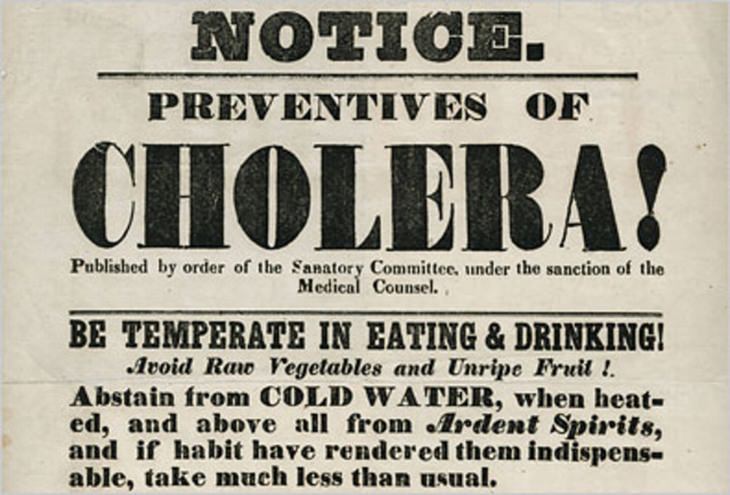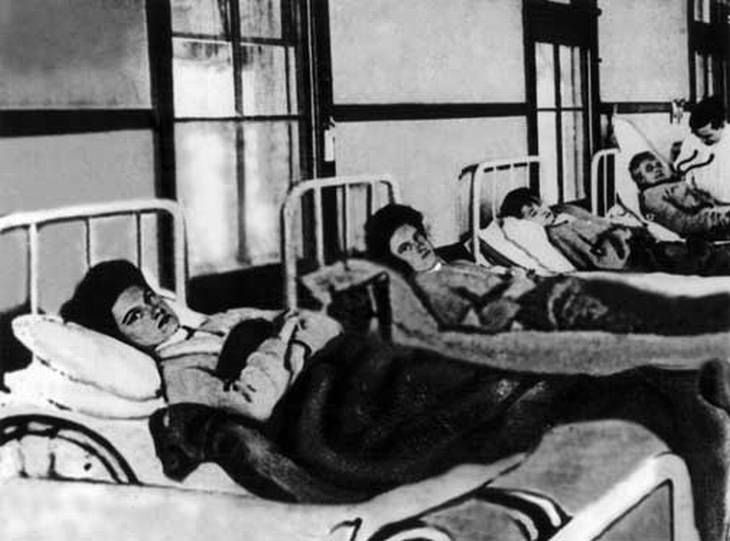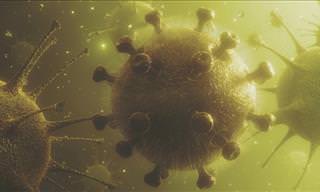1. 1633 - Small Pox
Smallpox is an ancient contagious disease, the symptoms of which are high fever, fatigue and a distinct rash all over one’s body. It was brought to North America by European settlers in the beginning of the 1600’s. While most Europeans were immune to the disease due to living condition in overpopulated Europe, smallpox spread like wildfire through the Native American population. By 1634 whole tribes were wiped out as death tolls skyrocketed to 8 out every 10 people infected dying.
Mortality Rate: 8/10 of infected individuals was killed.
How Did It End?
Smallpox epidemics were definitely not confined to 1633, and continued occurring every 10 years or so. In 1796 the English Physician Edward Jenner managed to develop a vaccination from cow pox, which was the world’s first vaccination against any disease. Thanks to Jenner’s invention, smallpox cases dropped radically and it was mostly eliminated in Europe by mid-20th century.
Can I Get Still Get It Today?
The short answer is no. Smallpox is the first disease to be completely eradicated. The World Health Organization (WHO) launched a large-scale vaccination program through Asia and Africa in the beginning of the 1970’s. The last smallpox infection worldwide was documented in October 1977 in Somalia. Nowadays, vaccines are no longer necessary as the virus is completely gone.
2. 1793 - Yellow Fever
In those days Philadelphia was considered the nation’s capital and it had one of the busiest ports. In the late summer of 1793, a ship came in carrying refugees who fled the epidemic spread of yellow fever in the Caribbean. The symptoms include fever, muscle pain, bloody vomit and yellowing of the skin as the name suggests. Some victims even became delirious before dying. By mid-October, a 100 people were dying of the disease every day.
The federal authorities, who were then seated in Philadelphia, simply fled the city. Other major port cities, like New York and Baltimore had quarantines against refugees and goods coming from Philadelphia.
Mortality Rate: 5000 people died between August 1st and Novemver 9th
How Did It End?
Similar to Malaria, yellow fever is carried by mosquitos. A wave of frost in late October killed the mosquitos and thus brought an end to the epidemic by November.
Can I Still Get It Today?
A vaccine was developed and licensed in 1953. Technically, it is still possible to get the disease in high risk areas like Central and South America and Africa. There is no cure for yellow fever but it is simple to prevent as one vaccination is enough for a lifetime.
3. 1832-1866: Cholera

There were three serious waves of Cholera spread in the US between those years. The epidemic had spread from India through the trade routes. Cholera causes severe diarrhea and dehydration and is typically spread through contaminated water. Immediate treatment is crucial, as in severe cases victims may die within few hours. New York City was usually the first to be hit and feel the impact. People of means escaped to the countryside, and the residents of the poor neighborhoods were the ones to suffer most heavily of the epidemic. Due to lack of understanding, victims were looked down upon and said to be sick because of their ‘dirty lifestyle’.
Mortality Rate: An estimated 2 to 6 American per die died during the peak of the outbreak.
How Did It End?
The reasons for the epidemic's end remain unclear. It may have been due to change of climate or quarantines. The last Cholera outbreak in the US was in 1911.
Can I Still Get It Today?
Modern sewage systems have helped to eradicate Cholera in some countries, but it is still a problem in countries struck by war, poverty and natural disasters. According to the CDC (Centers for Desease Control) 130,000 people worldwide still die of Cholera every year. The disease thrives where there is lack of sanitation, so the best way to prevent is to wash hands regularly with soap and avoid drinking contaminated water.
Treatments include antibiotics, zinc supplement and rehydration, and there is a vaccine you can get in case of traveling to a high risk area.
Related Article: 5 Important Vaccines for Older Adults
4. 1858 - Scarlet Fever
Scarlet Fever, also called scarlatina, is an infection caused by the same bacteria that causes strep throat and is actually an advanced manifestation of it. Its symptoms are a bright rash on the body, high fever and sore throat. 95% of those affected in the 1858 epidemic were children.
How Did It End?
As was the case with Cholera, it isn’t clear what caused the spreading of scarlet fever to stop. Modern research concludes it was probably an overall improvement in public health.
Can I still Get It Today?
Scarlet Fever is not considered dangerous today, as modern antibiotics make the disease follow a benign course. If left untreated, however, it could lead to a more serious condition. So if you are experiencing strep throat symptoms it’s important you seek treatment as soon as possible.
5. 1906-1907 – Typhoid Mary
Typhoid Fever, a contagious bacteria which causes fever, headaches and diarrhea, was associated with crowded slums, poverty and lack of basic sanitation. So when six family members of the household of wealthy banker Charles Warren were infected in the summer of 1906, it was a cause for great concern and bewilderment. A freelance sanitary engineer was hired to track the source of the outbreak, and the investigation led him right to Mary Mallon, the new household cook. It turned out 7 other families Mallon worked for since 1900 reported typhoid fever cases. The remarkable thing was, Mallon was a healthy carrier of the pathogen and never had any symptoms; she wasn’t even aware she had it. She directly infected 122 New Yorkers, five of which died from it.
Mortality Rate: A total of 10,771 people died of typhoid fever that year.
How Did It End?
Mary Mallon was forced to spend the last decades of her life in isolation. A vaccine was developed in 1911, as well as an antibiotic treatment in 1948.
Can I Still Get it Today?
Typhoid Fever is rare nowadays, but the CDC recommends getting vaccinated if you are traveling to high risk areas, especially India, Pakistan and Bangladesh.
6. 1918 - Spanish Flu

The mutating influenza virus circulates the globe every year, but the strain of 1918 developed to be especially fatal. It wasn’t restricted to Spain or the US, Spanish flu was a global crisis. At the time there was no effective means to fight this deadly flu strain. Citizens were ordered to wear masks and schools and businesses were shuttered. Victims sometimes died within hours of developing symptoms, which included their skin turning blue and their lungs filling with fluids to the point of suffocation. More US soldiers died in 1918 of flu than were killed in battle (don't forget World War I was still going on).
Morality Rate: 675,000 Americans died of Spanish flu.
How Did It End?
The flu pandemic came to an end by the summer of 1919, as those infected either died or developed immunity.
Can I still Get It Today?
‘Flu season’ still exists, and it generally runs from late fall into spring. There is a vaccination against it nowadays, but since the influenza mutates every year, the vaccination needs to be renewed annually.
7. 1916-1955 Polio
Polio is a viral disease which attacks the nervous system and causes paralysis. The first major polio pandemic occurred in 1916 and reached its peak in 1952. Parents were terrified of polio during the first half of the 20th century. For a time Polio was called infantile paralysis, although it did not affect children exclusively.
Morality Rate: About 3,145 people died of polio during its peak in 1952.
How Did It End?
A Vaccination was developed by Dr. Jonas Salk in 1955. Polio was eradicated from the US by 1979, and from the entire western hemisphere by 1994 .
Can I still Get It Today?
Polio vaccination is still recommended worldwide, because of the risk of imported cases. It still continues to circulate in Pakistan and Afghanistan. Intense vaccination programs are being conducted to eliminate these last pockets.
8. 1981-1991 Measles
Measles is a very contagious virus that can spread through the air. The symptoms are fever, runny nose, cough, red eyes and sore throat. A vaccination against Measles was introduced in the 1960s which caused cases of the disease to drop drastically. Interestingly, the main victims of the 1981 outbreak were vaccinated school-children.
Mortality Rate: Between 2000 and 10,000 people a year.
How Did It End?
Following the outbreak, doctors began to recommend a second dose of vaccine for everyone. Thanks to a highly effective vaccination program Measles was eradicated from the US by 2000.
Can I Still Get It today?
Measles is still common in many other countries, and it is still important to get vaccinated against it.
9. 2010, 2014 Whooping Cough
Pertussis, or whooping cough, is one of the most common diseases in the US. These coughing attacks can last months and are highly contagious. The group with the highest mortality risk are infants too young to be vaccinated.
Mortality Rate: 10 Infants died out of 10,000 cases.
How Did It End?
Whooping Cough is still not completely eradicated, and the CDC warns outbreaks may happen every three to five years. However, the occurrence of the disease is much less than it was.
Can I Get it Today?
As mentioned, it ia less likely but still possible. The CDC recommends that pregnant women get a vaccination during the third trimester to optimize protection of the baby.
 Go to BabaMail
Go to BabaMail

































